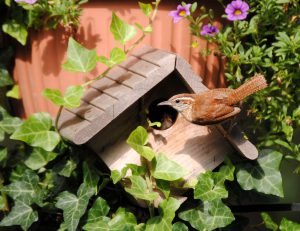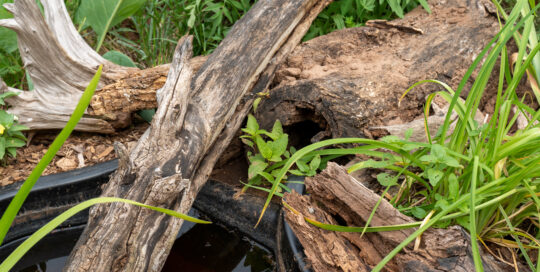The science (and art) of placing birdhouses
Views: 5447

In spring, some birds look for nesting boxes
With daffodils and fruit trees blooming, I know spring is well on its way. I heard a variety of spring bird songs in the yard this weekend. A reminder that it’s time to ensure birdhouses (nesting boxes) are ready for use. It’s good to clean out old nesting material if you haven’t done so already. Remove any spider webs, rodent nests, or other debris; and make sure the boxes are still securely fastened.
Science cannot always predict the whims of birds
One would believe that proper placement of nest boxes would be more science than art. If you need to mount new boxes or move old ones that have never been used, you can go online and find detailed instructions on how and where to place your bluebird house. I always try to follow these recommendations when placing my bird houses. However, in my experience, they rarely get used as expected.
A few years ago, my brother, Mike, braved a rickety, 15-foot ladder to attach a woodpecker house to an old tree well away from the house in a wooded area. Have woodpeckers ever used it? No. But it did serve as nesting box for a family of tufted titmice one spring, and a nut storage unit for a fox squirrel one winter. To our knowledge, woodpeckers have never used it. It blew down in a severe storm, so now I will relocate it.
Our beloved houses
We have a couple of wren houses strategically placed around the yard. I followed the instructions for placing the houses: 3-5 feet off the ground, near a tree or shrub that provides good shelter. Are they ever used? No. Not by wrens, anyway. Instead, our wrens build nests under our propane tank’s cover, or inside a storage shed that has a wren-sized entrance at the bottom. One year they used a decorative bird house that I put up five feet from our heavily-trafficked glass sliding door.
Last year they nested in a hanging basket right in front of our picture windows. We couldn’t water the plants in the basket once the nest was built, but we gladly sacrificed the plants for the joy of watching our wrens raise their little family. Apparently, Carolina wrens prefer dodging people, lawn mowers, and dogs to a nice secluded birdhouse positioned according to the prevailing internet wisdom on where to place a wren house.
One of our bluebird houses has been used almost every year we’ve lived here. But it doesn’t meet the recommendations for ideal bluebird house placement. I put another house in the yard, well away from that one, that is a better match. It is used as a roost for downy woodpeckers (I’ve seen them flying in and out more than once), but it has never been used as a nest.
When we first moved in, our neighbors had a martin house with purple martins in it. For unknown reasons, the neighbors took it down one summer. Thinking that was a shame, we put up a martin house, hoping the martins would come to us. Our house is less than fifty yards from where our neighbor’s house had been, but martins have never used it.
Provide nesting boxes anyway
Bird houses are a great addition to your landscape to help birds. But there is an art to placing the boxes – as much as there is a science. It’s a good idea to follow the recommendations for box placement for the bird species you are hoping to attract, but don’t get discouraged if you put up a house that isn’t used right away. It may be used next year, or it may be used as a roost by some bird needing shelter on a cold winter night.
One good website to find nest box information: Cornell University’s Lab of Ornithology’s Nestwatch.org (http://nestwatch.org/learn/all-about-birdhouses/). They even have an interactive tool to help you out. Enter your region and it will provide you a list of species that will use nest boxes in your area.
Meet Leslie Miller
Leslie Ann Miller shares 3.5 acres in rural Oklahoma with birds, butterflies and wide variety of animals. She is currently transforming her yard with plantings…
Leslie's Recent Posts

Creating microclimates and microhabitats to benefit wildlife






